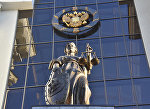MOSCOW, February 17 (RAPSI, Ingrid Burke) – Devoted wildlife conservationist Prince William would like to see the whole of Buckingham Palace’s ivory collection destroyed, as reported by The Independent on Sunday (IoS).
The IoS cited legendary primatologist Jane Goodall as having recounted Prince William’s desire “to see all the ivory owned by Buckingham Palace destroyed.”
In a speech delivered Wednesday during the London Conference on the Illegal Wildlife Trade 2014 (Conference), the prince spoke of the audience’s duty to wield its collective influence in bringing an end to the illegal wildlife trade.
The conference attracted governmental representatives from around the globe, including Russia.
In urging the imperative of an industry takedown, the prince pointed out several alarming statistics: “The illegal wildlife trade is now the 4th most lucrative transnational crime after drugs, arms and human trafficking. It is estimated to be worth between 10 and 20 billion dollars each year.”
A press release issued by the UK government following the conference added that demand for illegal wildlife products has increased dramatically over the course of the past decade. The poaching of rhinos increased by 5,000% between 2007 and 2012 – according to the release, with one being killed by a poacher with the passage of every ten hours.
Most ominously, “Since 2004 the Central Africa region has lost two-thirds of its elephant population, and last year saw the Western Black Rhino declared extinct.”
Noting that the dangers posed by the industry reach beyond the animal kingdom, Prince William asserted that upwards of 1,000 rangers have been killed in the past decade – adding that on average, two rangers are murdered by poachers every week.
Furthermore, there is “evidence that poachers' activities are funding international terrorism,” the prince claimed.
He explained that the illegal wildlife trade has grown increasingly sophisticated, with poachers now operating in international criminal groups, and that the black market for these illicit goods has grown more easily accessible thanks to the Internet.
Prince William serves as president of the conservation organization United for Wildlife, which advocates action in certain key areas, including through the use of drones and other sophisticated new technologies, according to the speech.
He further encouraged the necessity of working with local legal systems: “We need to support the judiciary and local authorities to combat trafficking, and to shine a spotlight on successful law enforcement.”
The conference culminated in the production of a Declaration summarizing various political commitments and agreed-upon actions that would be taken by the international community in the name of clamping down on the industry.
The group members called upon the international community to provide the political leadership and practical support necessary for the implementation of various actions aimed at eradicating the illegal wildlife market, beefing up relevant legislative frameworks, bolstering law enforcement efforts, providing for sustainability and economic development within local communities impacted by the trade, and spearheading future initiatives to maintain momentum as the fight against the trade continues.
Meanwhile, a great deal of progress was announced earlier this month in the international fight against the illegal wildlife trade.
Upwards of 400 arrests and 350 major wildlife seizures were made during the course of the recently wrapped Operation Cobra II – a month-long global operation aimed at clamping down on crimes against wildlife, according to a statement released on the Convention on International Trade in Endangered Species of Wild Fauna and Flora (CITES) website on February 10.
The cooperative effort, carried out by officers from 28 law enforcement agencies around the world, was notable in bringing about the first ever joint China-Africa sting operation, which led to the identifications and arrests of members of a large-scale ivory trafficking group.
Officers collected a treasure trove of black market goods, including: 36 rhinoceros horns, over three metric tons of elephant ivory, upwards of 10,000 turtles, over 1,000 protected-species skins, more than 10,000 European eels, and over 100 tons of rosewood logs.
A second CITES release noted that the seizures came from a broad range of wildlife, including cheetah, elephant, rhinoceros, pangolin, leopard, snake, tiger, turtle, and rosewood.
The 400 arrests were made in Asia and Africa, and included kingpins in the trafficking industry, according to the statement.
The project was carried out by law enforcement and wildlife officials in Botswana, Brunei, Burundi, Cambodia, China and Hong Kong, Congo, Ethiopia, Ghana, India, Indonesia, Kenya, Laos, Liberia, Malawi, Malaysia, Myanmar, Mozambique, Nepal, the Philippines, Singapore, South Africa, Thailand, Uganda, Tanzania, the US, Viet Nam, Zambia, and Zimbabwe.
Praising the project’s outcome, CITES Secretary General John Scanlon said in a statement: “This second Operation COBRA initiative shows what can be achieved when law enforcement authorities across range, transit and destination States work together in a coordinated manner. It also serves to highlight that intelligence-led operations are essential in the fight against transnational organized wildlife crime.”


